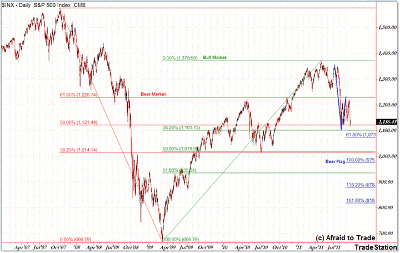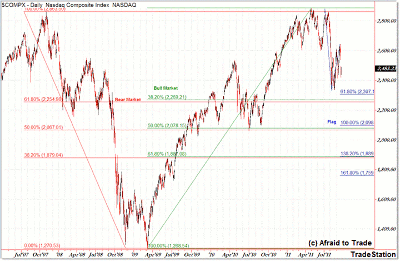Fibonacci clusters are appearing on the charts for the S&P 500, Dow, and Nasdaq, and clear support levels are now evident for all three of these major indexes.
With the US equity markets currently sitting atop a longer-term Fibonacci cluster level, let’s take a look at the Dow Jones, Nasdaq, and S&P 500 in terms of their recent “bear market” and “bull market” Fibonacci retracement levels.
See related: Fibonacci Analysis: Master the Basics
Let’s start first with the S&P 500:
This is roughly identical to the recent “Major Fibonacci Clusters to Watch” article I wrote for Monday, except today’s post extends that logic to the Nasdaq and Dow Jones Indexes for reference.
In today’s article, I also labeled a Fibonacci projection based on the “bear flag” price-pattern formation that many traders are discussing.
For reference in all posts:
- The red grid represents the Fibonacci retracements from the “bear market” from October 2007 to March 2009
- The green grid represents the “bull market” Fibonacci retracements from March 2009 to May 2011
- The blue grid represents the “bear flag” projection target level, which comes into play only on a break under 2011 index lows
I’ll let the charts speak for themselves, calling your attention to the two immediate support levels in each index.
NEXT: Review Fibonacci Support Levels for S&P, Dow, and Nasdaq
|pagebreak|In the S&P 500, the current level has held support at 1,101 (38.2% bull) and 1,121 (50% bear). This gives us a cluster between 1,100 and 1,120, which we’re all watching.
Beneath the 1,100 level, the next cluster forms at 1,015, which happens to coincide with the 2010 low of 1,010. The index would be expected to fall to this level on a firm break of the current support grid.
Now, on to the Dow Jones index, which carries a similar message as the S&P 500:
The immediate support cluster for the Dow Jones is slightly lower, forming a convergence at the 10,400 level as seen above.
In the event the Dow Jones trades under the 10,400 support cluster, the next downside cluster forms at 9,550 to 9,650, which includes the 2010 swing low of 9,614. For simplicity, one could easily reference a downside cluster at 9,600, though 10,000 would be a key psychological level to watch.
Finally, the Nasdaq shows a different chart picture due to the stronger “bull market” rally from 2009 that actually peaked at a new recovery high:
First things first: Because the red, “bear market” Fibonacci grid begins at roughly the same level as the “bull market” grid, the confluences you see above aren’t as valuable a reference as the different grids generated for the S&P 500 and Dow Jones.
In other words, the confluences in the Nasdaq are a result of the two grids originating from an identical bottom (March 2009) with near-identical tops (October 2007 and May 2011).
Anyway, the first downside support level forms near 2,270 or the 2,300 “easy reference” index level.
Under 2,300 is the “bear flag” projection which coincides with the 2010 low (2,061) and the Fibonacci level near 2,070.
See related: Using Fibonacci to Trade Flag Patterns
These “bigger-picture” Fibonacci reference grids will not change, unless price in the next few months happens to break to new recovery highs above respective 2011 peaks.
Use charts as reference grids in terms of long-term Fibonacci retracement levels in the US equity indexes.
By Corey Rosenbloom, trader and blogger, AfraidToTrade.com
























